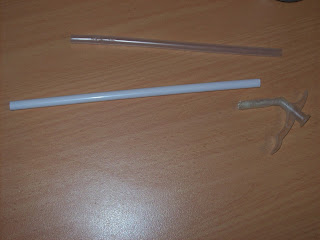I needed a PC in the shed for programming work. Given the lack of space, the easiest thing to do was put the PC in a wheel-able cabinet, and packaged in such a way to permit it to be collapsed as small as possible.
I'd rescued an old 3M overhead projector a couple of years ago, and the wheeled stand it came on... This stand, with a few modifications, became the PC cabinet.
The original stand had a top which was set approx 6" (150mm) under the level of the top vertical posts, and the 2 flip out leaves attached to the posts. I raised the top shelf to line up with the posts, and then closed in the underside on 3 sides with some old sheet metal. I took another piece of metal to work and bent it up to make a door for the fourth side.

The "front door" of the PC cabinet is the grey sheet of metal on the RHS of the picture - with black cloth tape covering the cut edges for hand protection.

The above photo shows the LHS leaf in the raised position - whereas the other photos in this article show both as lowered.
The PC is an antique (old celeron from memory) but it does what I need (runs the PICAXE suite of software). Network is accessible (if I run out the 15m patch lead) and the speakers, mouse and keyboard cabling is wrapped in a spiral wrap and pinned under the top shelf.
Currently (due to other projects) the most this PC does is play music for the shed area - the programming has been on hold for a few weeks now due to other commitments.

As part of the PICAXE work, I needed to rig up a 5VDC power supply for the breadboard and other circuit prototypes. Digging through my boxes of salvaged gear I found a near new 5VDC SMPSU. Using some scrap pexiglass, I fashioned up a board with the SMPSU encapsulated at the top. The scrap pexiglass had some bends in it already, and I used them to form the cover for the 240VAC section, and to mount the power switch.

It was a simple case of then bringing the 5VDC and COM rails out to the prototyping area by means of the terminal block. I also brought the mains Earth out as well. The colour code for the terminal positions is shown on the LHS of the cover.
LRF are applied on the bottom of the unit to stop the fixing screws from scratching up the top of the cabinet.

The unit fits nicely in the box with the other electronics bits.

Why PICAXE?
I needed something, and I was so out of date with my previous experience (6502, 8086, pic16f84) that I asked on the newsgroups what was the best to come back in with... the suggestions included Arduino and other systems, but PICAXE came through loud and clear as suited for what I'm trying to do...
I've a project to help someone who's eyesight is going. He's a machinist who's finding it hard to use a standard dividing head - I can't afford a "DivisionMaster" (excellent product designed by Tony Jeffree) so I'll try and build my own version (with several features not in the original - suited to the user's tasks) and bring my skills back up at the same time.
That is the story of my life so far - get an idea to do something, identify pre-requisite equipment and skills, acquire those, find there are more needed, etc ad nauseum.
Kinda the model engineer creed - "Build a jig to build a tool, to build a jig, to build a tool, to build a jig to build a project". In my case the lathe was bought to build a micro hybrid rocket motor, but the lathe needed parts so I started building parts, which meant I needed the furnace, which meant I needed to learn.... and on the story goes.
Don't take the above as a complaint - by the time I build that motor I'll have a fully equipped workshop, an amazing set of skills, and a very diverse set of experience - all I need is time... and patience... and space for junk... and money for bits... :)












